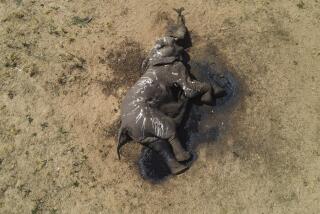Overabundant Elephants Make Out Like Pigs, or Simply Giant Pests, in Zimbabwe
- Share via
KARIBA, Zimbabwe — If saving elephants is a good thing then the inhabitants of this quiet community in the Zimbabwe highlands have too much of a good thing.
The pachyderms are pests to the people of Kariba. They drink from the town swimming pool and they tromp through flower gardens stripping the tops off trees. They seem to eat any vegetation in sight. And there’s not much anybody can do about it.
They have even killed a few people around here.
While many other African countries are losing their wildlife to poachers and changing environments, Zimbabwe has maintained a successful conservation program over three decades. Its biggest problem is not how to stop elephant poaching; it is how to cope with the proliferation that results from success.
“The rainy season hasn’t been 100% over the last couple of years. The trees dry out and the elephants come into town looking for vegetation,” said Dusty Gates, who has lived 28 years in Kariba, a hilltop town of about 25,000 overlooking a scenic lake and a valley teeming with African wildlife.
“They just go straight through and help themselves,” he said.
The Gates’ three-bedroom home near the center of town has been a frequent target of the giant intruders that stomp into their front lawn, ripping through the outside fence and helping themselves to the big mango tree that shades the house.
To defend their home, Gates and his wife Maureen have invented elephant deterrents. They hung a sheet of netting at the entrance of their back patio in an effort to save the orchids and lilies. Gates also constructed an “elephant intruder alarm” with wires running from their bedroom window to the mango tree about 15 yards away. When a large animal walks into the wires, it sets off a loud “hooter” in the front yard and triggers a light in the Gates’ bedroom.
“We come out and bang pots and pans to scare it off,” Maureen Gates explained. “There was one here night before last. He was standing there rubbing his belly on that tree.”
Kariba residents have to cope with wildlife outside their windows because they live in a town surrounded by national park areas where the animals abound.
“We’re an urban area located in a national park area. Obviously there are bound to be problems between people and animals,” said Godfrey Magombedzi, Kariba’s town clerk. He said five or six people had been killed by elephants or buffalo over the last decade, but the entire town had to cope with the routine destruction of property and the general menace.
“The problem is not only when people get killed. It’s the harassment. People can’t move freely. You can’t go from your home to the pub. This destroys the social fabric,” he said.
Nearly 13% of the land in California-sized Zimbabwe has been set aside as national parks, which are at the center of a thriving tourist industry.
National parks officials say the country has 70,000 elephants, twice the number the land can sustain, and they want to kill off--or cull--about half so the other half can survive and live in harmony with the human population.
They also want to sell the ivory from this culling and use the money to benefit local communities, particularly in rural areas, that must live with the menace of wild animals. But that position puts Zimbabwe at odds with the Swiss-based Convention on International Trade in Endangered Species, the international body that imposed a worldwide ban two years ago on the sale of ivory.
Zimbabwe and several other countries with large elephant populations, including Malawi, Botswana and South Africa, opposed the ivory ban in 1989 and hope to reverse it in March when the international conservation body meets in Japan. The ban was supported by other African countries such as Kenya, where authorities have not been able to control illegal poaching.
More to Read
Sign up for Essential California
The most important California stories and recommendations in your inbox every morning.
You may occasionally receive promotional content from the Los Angeles Times.













